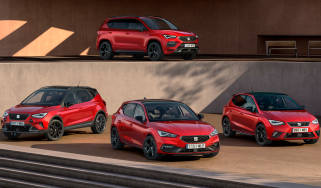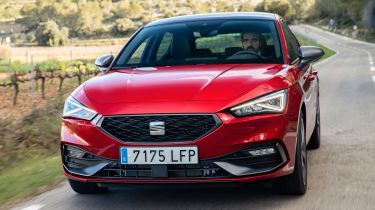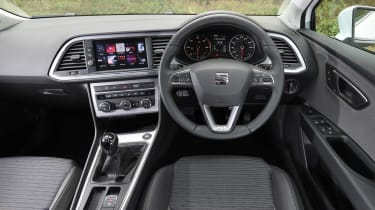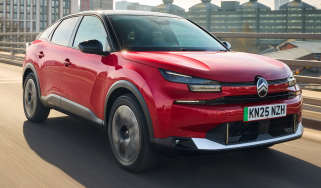SEAT Leon: old vs new
The fourth-generation SEAT Leon is available to order, but is it better than the old one?
The SEAT Leon is a popular family hatchback, offering all the Golf's sensible attributes but with a touch of Latin flair. Sharp looks helped to keep the old Leon fairly fresh - it's hard to believe it first arrived seven years ago - but the new car is more than just a mild update.
Design, engines and safety kit all get a major overhaul, but it's the car’s technology that sees the most radical upgrade. The infotainment system is now one of the best in the family car class, which is no mean feat when rivals include the Ford Focus, Volkswagen Golf, Mazda3 and Honda Civic.
Design
In the past, SEAT implemented stark styling changes for each new Leon, particularly in the case of the curvaceous second-generation car. This fourth-gen model isn't quite as much of a jump, showing just how successful the old car was. Its side profile in particular retains the same sharp creases and sporty door-mounted mirrors. Park the cars side by side, however, and you'll notice the wheelbase (the distance between the front and rear axles) has been stretched by 50mm.
The new Leon's nose looks a bit meaner as well, with a plunging bonnet and wide lower grille that wraps around the front of the car. Angular headlights with pin-sharp LED daytime running lights complete the look. Fellow motorists will be in no doubt they're following the new model at night, thanks to a wide 'coast-to-coast' LED strip across the boot. FR trims arguably look best, thanks to aggressive body-coloured bumpers, chrome tailpipes and bigger alloy wheels.
Interior
The changes inside are perhaps even more significant. The old Leon had a competitive eight-inch infotainment screen but the new model feels truly connected to online features, while the screen has become a key feature of the interior design. The clear 10-inch display looks rather like an iPad mounted above the air vents, and dash buttons are few and far between. In fact, SEAT's designers may even have taken this a bit too far, as not everyone will relish the touch-sensitive temperature control, which can be rather fiddly.
A major criticism of the old Leon was that its interior was notably more budget than the Golf's, both to make the SEAT a bit cheaper to buy and to stop it treading on the Golf’s toes. This gap has narrowed in recent years, and in the Mk4 Leon the distinction is even smaller. The old car had more scratchy, hard plastics and where digital instruments were fitted, they felt like more of an afterthought than the Digital Cockpit in the new car.
Economy and performance
In keeping with its sporty looks, the Leon is also a fun car to drive. The suspension feels a bit firmer than in the VW, encouraging the driver to tackle challenging roads and put the car into its more aggressive driving modes. The changes from its predecessor are fairly slight in this department, though, so the Mazda3 and Ford Focus are still likely to prove even sharper when we get to drive them back-to-back. The new car has similar engines to before but is slightly bigger, so the older Leon's performance still looks good on paper. In fact, the new 1.5-litre TSI petrol model is 0.2 seconds slower to 62mph - an amount you're unlikely to ever notice.
In better news, the entry-level 1.6-litre diesel has been replaced by a 2.0-litre engine that's not only more efficient, but should feel more flexible from low revs, despite having the same 113bhp. The diesel will also produce less tailpipe pollution than the Mk3 because emissions-reducing AdBlue fluid is now injected in two places in the exhaust system instead of one.
SEAT has also introduced mild-hybrid hardware to the 1.0-litre TSI and 1.5-litre TSI petrol engines, badged eTSI. This harvests energy under braking to help power the car's electrics and allow engine-off coasting. A plug-in hybrid Leon badged eHybrid will also arrive, fitted with a 13kWh battery pack that can provide up to 38 miles of engine-off driving when fully charged.
Practicality
The latest Leon has grown by 86mm in length, so if you've ever found the back seats of the Mk3 too cramped, the new model could be worth it. With 50mm of extra bodywork between the front and rear wheels, there's now noticeably more legroom and knee room for passengers. Wide-opening back doors should also make it easier to get in and out, and for parents to load child car seats.
Boot space remains identical to the old car, with 380 litres behind the back seats. This matches the Volkswagen Golf but falls short of the Honda Civic, which has a 478-litre boot.
Safety
The Mk3 Leon was respectable when it came to safety, with a five-star rating from independent body Euro NCAP. While the new car hasn't been tested yet, we'd be shocked if it didn't do even better. That's thanks to the arrival of the latest safety technology.
This includes 'CartoX' cloud-based software, which sounds like something out of a Hollywood action film but allows the Leon to communicate with other cars and local infrastructure. Benefits include hyper-local updates on accidents and hazards, and even the colour of upcoming traffic lights.
A myriad of sensors are also fitted to the latest Leon to help detect when a collision is imminent and help avoid it. They also help make the Predictive Adaptive Cruise Control more accurate, automatically speeding up and slowing down the car in traffic.
Verdict
The Mk3 Leon is still a great car and, while the upgrades to the Mk4 are noticeable, you’re likely to remain satisfied with the old one for the time being. When it comes time to upgrade, though, the latest model makes a strong case as an even better all-round family car.
Interior space is better, especially for those in the back, technology is now bang up to date and it's fitted with the Volkswagen Group's latest engines. These have been upgraded to meet the strictest European emissions legislation, and features like mild-hybrid, and even plug-in hybrid, hardware make them cheaper to run and better for the environment.
Read our in-depth reviews of the latest SEAT Leon and its predecessor.
Recommended

SEAT releases new Black Edition models with sportier styling
Most Popular

Omoda E5 targets rivals: now with zero deposit and APR

Ford Puma Gen-E driven: Electric charmer or too little, too late?
Tips & advice

Car dashboard warning lights: what does each symbol mean?

Electric car charging stations: public networks, charger types, apps and maps












